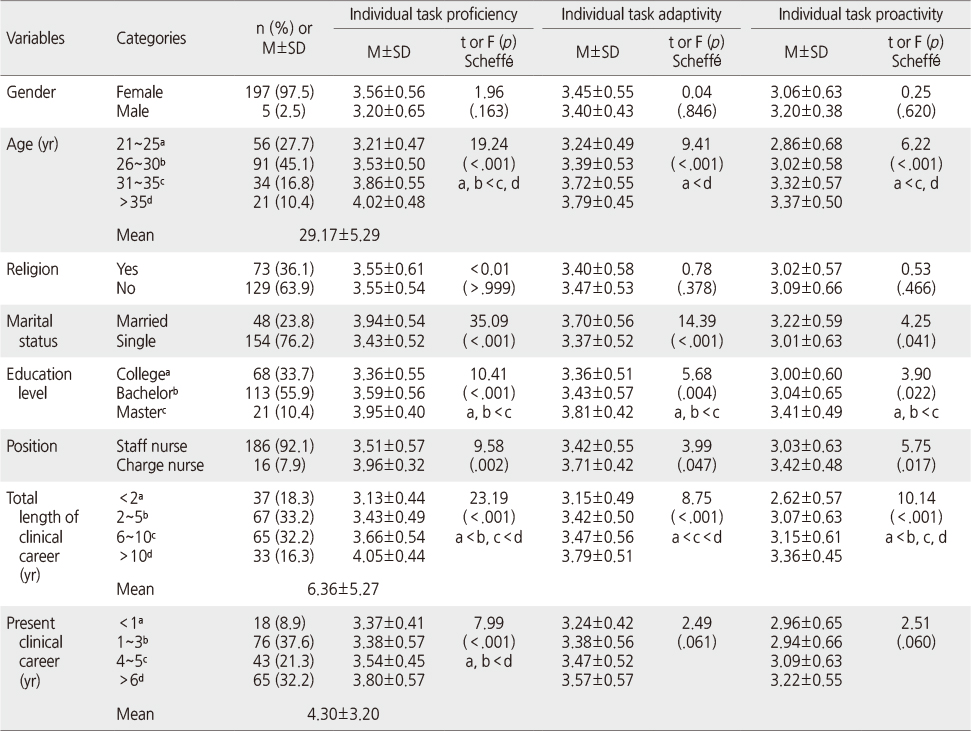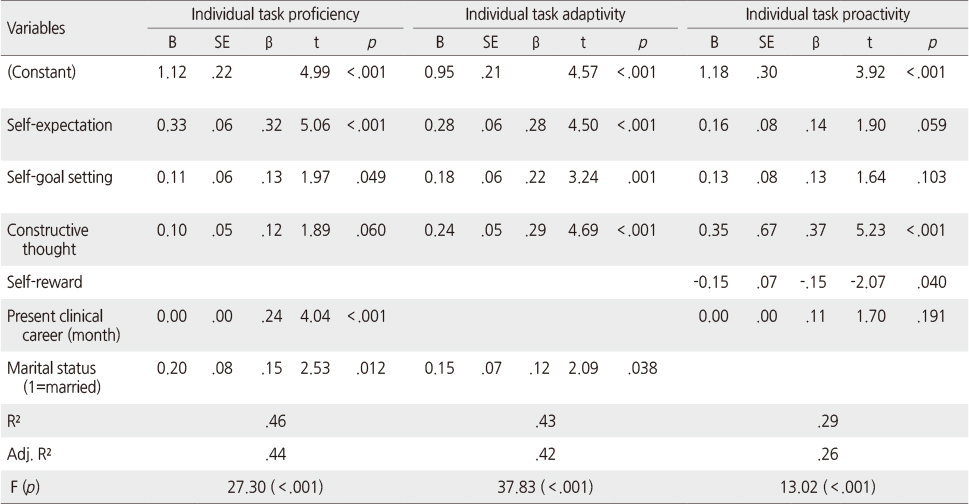Articles
- Page Path
- HOME > J Korean Acad Nurs > Volume 46(3); 2016 > Article
-
Original Article
- Influence of Nurses' Self-leadership on Individual and Team Members' Work Role Performance
- Se Young Kim, Eun-Kyung Kim, Byungsoo Kim, Eunpyo Lee
-
Journal of Korean Academy of Nursing 2016;46(3):338-348.
DOI: https://doi.org/10.4040/jkan.2016.46.3.338
Published online: June 30, 2016
1Department of Nursing, Changwon National University, Changwon, Korea.
2Department of Nursing, Chungbuk National University, Cheongju, Korea.
3Department of Statistics, Inje University, Gimhae, Korea.
4College of Nursing, Eulji University, Daejeon, Korea.
- Address reprint requests to: Kim, Eun-Kyung. Department of Nursing, Chungbuk National University, Chungdae-ro 1, Seowon-gu, Cheongju, Chungbuk 28644, Korea. Tel: +82-43-249-1730, Fax: +82-43-266-1710, kyung11@cbnu.ac.kr
© 2016 Korean Society of Nursing Science
This is an Open Access article distributed under the terms of the Creative Commons Attribution NoDerivs License. (http://creativecommons.org/licenses/by-nd/4.0/) If the original work is properly cited and retained without any modification or reproduction, it can be used and re-distributed in any format and medium.
Abstract
-
Purpose
- The purpose of this study was to examine correlations between nurses' self-leadership and individual work role performance and correlations between self-leadership in nursing units and team members' work role performance.
-
Methods
- Participants were 202 conveniently selected general nurses from 5 general hospitals in Korea. The study was carried out on 35 nursing units. Data were collected during February 2015 with self-report questionnaires.
-
Results
- For factors affecting individual work role performance, self-expectation, self-goal setting, constructive thought, clinical career in the present nursing unit and marital status accounted for 44.0% of proficiency, while self-expectation, self-goal setting, constructive thought, and marital status accounted for 42.3% of adaptivity. Self-expectation, self-goal setting, constructive thought, self-reward, clinical career in the present nursing unit and position accounted for 26.4% of proactivity. In terms of team members' work role performance, self-reward and self-expectation in nursing units explained 29.0% of team members' proficiency. Self-reward and self-expectation in nursing units explained 31.6% of team members' adaptivity, and self-reward in nursing units explained 16.8% of team members' proactivity.
-
Conclusion
- The results confirm that nurses' self-leadership affects not only individual self-leadership but also team members' work role performance. Accordingly, to improve nurses' work role performance in nursing units of nursing organizations, improvement in nursing environment based on self-leadership education is necessary and nurses' tasks rearranged so they can appreciate work-autonomy and challenges of work.
This paper was supported by research funds of Changwon National University in 2014.
The authors declared no conflicts of interest.
- 1. Min BC, Lim SW, Kim HK, Rhee HS. The influence factors and effects of self-leadership: Focusing on members of the hospitals. Health Policy Manag. 2013;23(1):66–77. Article
- 2. Irvine D, Leatt P, Evans MG, Baker RG. Measurement of staff empowerment within health service organizations. J Nurs Meas. 1999;7(1):79–96.ArticlePubMed
- 3. Neck CP, Houghton JD. Two decades of self leadership theory and research: Past developments, present trends, and future possibilities. J Manag Psychol. 2006;21(4):270–295.
- 4. Manz CC, Sims HP. SuperLeadership: Beyond the myth of heroic leadership. Organ Dyn. 1991;19(4):18–35. Article
- 5. Konradt U, Andreßen P, Ellwart T. Self-leadership in organizational teams: A multilevel analysis of moderators and mediators. Europ J Work Organ Psychol. 2009;18(3):322–346. Article
- 6. Prussia GE, Anderson JS, Manz CC. Self-leadership and performance outcomes: The mediating influence of self-efficacy. J Organ Behav. 1998;19(5):523–538. Article
- 7. Politis JD. Self leadership behavioural focused strategies and team performance: The mediating influence of job satisfaction. Leadersh Organ Dev J. 2006;27(3):203–216.
- 8. DiLiello TC, Houghton JD. Maximizing organizational leadership capacity for the future: Toward a model of self leadership, innovation and creativity. J Manag Psychol. 2006;21(4):319–337.
- 9. Korean Nurses Association. The power of nursing leadership [Internet]. Seoul, Author. 2006;cited 2015 April 15. Available from: http://webzine.koreanurse.or.kr/Webzine/webzine_list.php?webzine_id=19&page=1
- 10. Kim HK. Influence of interpersonal relations, communication skills, creative behaviors and nursing services on self-leadership among nurses in hospitals. J Korean Clin Nurs Res. 2007;13(1):25–36.
- 11. Kang YS, Choi YJ, Park DL, Kim IJ. A study on nurses' self-leadership, self-esteem, and organizational effectiveness. J Korean Acad Nurs Admin. 2010;16(2):143–151. Article
- 12. Won HJ, Cho SH. A review of research on self-leadership in nurses'. J Korean Acad Nurs Admin. 2013;19(3):382–393. Article
- 13. Ilgen DR, Pulakos ED. Employee performance in today's organizations. In: Ilgen DR, Pulakos ED, editors. The changing nature of performance: Implications for staffing, motivation, and development. San Francisco, CA: Jossey-Bass Inc.; 1999. p. 21–55.
- 14. Hauschildt K, Konradt U. The effect of self-leadership on work role performance in teams. Leadersh. 2012;8(2):145–168. ArticlePDF
- 15. Murphy PR, Jackson SE. Managing work role performance: Challenges for twenty-first century organizations and their employees. In: Ilgen DR, Pulakos ED, editors. The changing nature of performance: Implications for staffing, motivation, and development. San Francisco, CA: Jossey-Bass Inc.; 1999. p. 325–365.
- 16. Griffin MA, Neal A, Parker SK. A new model of work role performance: Positive behavior in uncertain and interdependent contexts. Acad Manag J. 2007;50(2):327–347. Article
- 17. Faul F, Erdfelder E, Buchner A, Lang AG. Statistical power analyses using G*Power 3.1: Tests for correlation and regression analyses. Behav Res Methods. 2009;41(4):1149–1160. ArticlePDF
- 18. Yang NY, Moon SY. Relationship of self-leadership, stress and satisfaction in clinical practice of nursing students. J Korean Acad Nurs Admin. 2011;17(2):216–225. Article
- 19. Maas CJM, Hox JJ. Robustness issues in multilevel regression analysis. Stat Neerl. 2004;58(2):127–137. Article
- 20. Manz CC. The art of self-leadership: Strategies for personal effectiveness in your life and work. Englewood Cliffs, NJ: Prentice-Hall; 1983.
- 21. Kim HS. The relationship between teachers' self-leadership and the job satisfaction at secondary schools [master's thesis]. Seoul, Soongsil University. 2003;1–83.
- 22. Seomun GA, Chang SO, Cho KH, Kim IA, Lee SJ. The relation between self-leadership and outcome of nursing practice. J Korean Acad Nurs Admin. 2006;12(1):151–158.
- 23. Kim JY, Hong JY. Self-leadership, job stress and job satisfaction among clinical nurses. J Korean Acad Nurs Admin. 2007;13(2):184–190.
- 24. Cho H, Ko YA, Kang YS, Lee G. Self-leadership and self-concept in the freshmen of nursing college. J Korean Public Health Nurs. 2011;25(1):107–117.
- 25. Lee JY, Cho MH. Correlations between self-leadership, critical thinking disposition and problem solving process in a diploma nursing students. J Korea High Vocat Educ Assoc. 2012;13(3):241–253.
- 26. Dolbier CL, Soderstrom M, Steinhardt MA. The relationships between self-leadership and enhanced psychological, health, and work outcomes. J Psychol. 2001;135(5):469–485. ArticlePubMed
- 27. Schmitt N, Cortina JM, Ingerick MJ, Wiechmann D. Personnel selection and employee performance. In: Borman WC, Ilgen DR, Klimoski RJ, editors. Handbook of psychology: Industrial and organizational psychology. Volume 12. Hoboken, NJ: John Wiley & Sons; 2003. p. 77–105.
- 28. Van Scotter JR, Motowidlo SJ. Interpersonal facilitation and job dedication as separate facets of contextual performance. J Appl Psychol. 1996;81(5):525–531.Article
- 29. Daellenbach US, McCarthy AM. Commitment to innovation: The impact of top management team characteristics. Res Dev Manag. 1999;29(3):199–208. ArticlePDF
- 30. Uhl-Bien M, Graen GB. Individual self-management: Analysis of professionals' self-managing activities in functional and crossfunctional work teams. Acad Manag J. 1998;41(3):340–350. Article
REFERENCES
Figure & Data
REFERENCES
Citations

- A comprehensive assessment of self-leadership among students in China’s ethnic regions: insights and implications for higher education
Conghuan Zhao, Yuan Wang
Studies in Higher Education.2025; 50(3): 615. CrossRef - Advancing the Construct of Self-Leadership: A Bibliometric Review
Evan A. Reichard, Daniel J. Smith, Rebecca J. Reichard, Jeffery D. Houghton
Journal of Leadership & Organizational Studies.2025; 32(2): 149. CrossRef - Effects of Preceptors’ Clinical Teaching Behavior on the Field Adaptation of New Graduate Nurses: Mediating Effects of Self-Leadership and Resilience
Eunjung Kim, Eungyung Kim
Journal of Korean Academy of Nursing Administration.2023; 29(5): 577. CrossRef - RETRACTED: Association of Self-Leadership With Acute Stress Responses and Acute Stress Disorders in Chinese Medics During the COVID-19 Pandemic: A Cross-Sectional Study
Rongjian Ji, Lan Zhang, Yanbo Ji, Guangzhao Li, Renxiu Wang, Cuiping Xu
Frontiers in Psychiatry.2022;[Epub] CrossRef - A concept analysis of self‐leadership: The “bleeding edge” in nursing leadership
Nompumelelo Ntshingila, Charlene Downing, Marie Hastings‐Tolsma
Nursing Forum.2021; 56(2): 404. CrossRef - Impact of self‐efficacy on the self‐leadership of nursing preceptors: The mediating effect of job embeddedness
Hyunju Kim, Kisook Kim
Journal of Nursing Management.2019; 27(8): 1756. CrossRef - Factors related to Self-leadership of Korean Clinical Nurses: A Systematic Review and Meta-analysis
Kyoung-Hee Yu, Hyunyoung Park, Keum-Seong Jang
Journal of Korean Academy of Nursing Administration.2018; 24(5): 410. CrossRef
Differences of Sub-scales of Individual Work Role Performance according to Characteristics of Participants (N=202)
Correlations between Individual Self-leadership and Individual Work Role Performance (N=202)
Factors Influencing Sub-scales of Individual Work Role Performance (N=202)
Correlations between Team Self-leadership and Team Member's Work Role Performance (N=35)
Factors Influencing Sub-scales of Team Member's Work Role Performance (N=35)
 KSNS
KSNS
 E-SUBMISSION
E-SUBMISSION





 Cite
Cite

